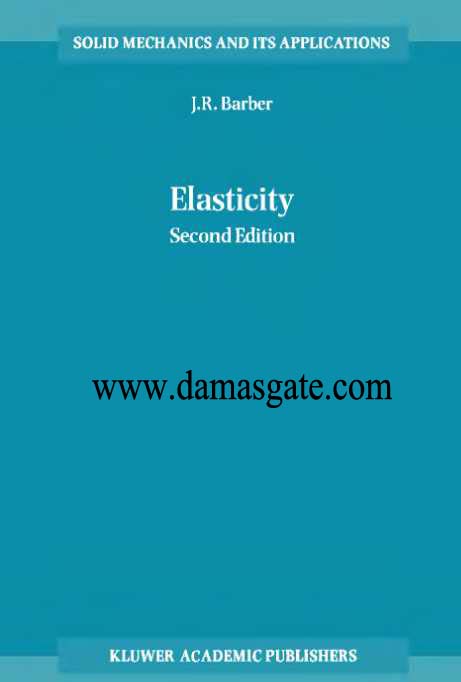Elasticity Second Edition, J. R. Barber

Product description
SynopsisThis is a first year graduate textbook in Linear Elasticity. It is written with the practical engineering reader in mind, dependence on previous knowledge of Solid Mechanics, Continuum Mechanics or Mathematics being minimized. Most of the text should be readily intelligible to a reader with an undergraduate background of one or two courses in elementary Mechanics of Materials and a rudimentary knowledge of partial differentiation. Emphasis is placed on engineering applications of elasticity and examples are generally worked through to final expressions for the stress and displacement fields in order to explore the engineering consequences of the results. The Topics covered were chosen with a view to modern research applications in Fracture Mechanics, Composite Materials, Tribology and Numerical Methods. Thus, significant attention is given to crack and contact problems, problems involving interfaces between dissimilar media, thermo elasticity, singular asymptotic stress fields and three-dimensional problems. This second edition includes new chapters on antiplane stress systems, Saint-Venant torsion and bending and an expanded section on three-dimensional problems in spherical and cylindrical coordinate systems, including axisymmetric torsion of bars of non-uniform circular cross-section. It also includes over 200 end-of-chapter problems, which are expressed wherever possible in the form they would arise in engineering - i.e. as a body of a given geometry subjected to prescribed loading - instead of inviting the student to 'verify' that a given candidate stress function is appropriate to the problem. Solution of these problems is considerably facilitated by the use of modern symbolic mathematical languages such as Maple(r) and Mathematica(r) and electronic files and hints on this method of solution can be accessed at the web site .
Table Of Content
Preface to the Second Edition. Preface to the first edition. I: General Considerations. 1. Introduction. 2. Equilibrium and Compatibility. II: Two-dimensional Problems. 3. Plane Strain and Plane Stress. 4. Stress Function Formulation. 5. Problems in Rectangular Coordinates. 6. End Effects. 7. Body Forces. 8. Problems in Polar Coordinates. 9. Calculation of Displacements. 10. Curved Beam Problems. 11. Wedge Problems. 12. Plane Contact Problems. 13. Forces, Dislocations and Cracks. 14. Thermoelasticity. 15. Antiplane Shear. III: End Loading of the Prismatic Bar. 16. Torsion of a Prismatic Bar. 17. Shear of a Prismatic Bar. IV: Three Dimensional Problems. 18. Displacement Function Solutions. 19. The Boussinesq Potentials. 20. Thermoelastic Displacement Potentials. 21. Singular Solutions. 22. Spherical Harmonics. 23. Cylinders and Circular Plates. 24. Problems in Spherical Coordinates. 25. Axisymmetric Torsion. 26. Frictionless Contact. 27. The Boundary-value Problem. 28. The Penny-shaped Crack. 29. The Interface Crack. 30. The Reciprocal Theorem. A: Using Maple and Mathematica. Index.
Download
*
File extension djvu
You need WinDjView to open it
*

Product description
SynopsisThis is a first year graduate textbook in Linear Elasticity. It is written with the practical engineering reader in mind, dependence on previous knowledge of Solid Mechanics, Continuum Mechanics or Mathematics being minimized. Most of the text should be readily intelligible to a reader with an undergraduate background of one or two courses in elementary Mechanics of Materials and a rudimentary knowledge of partial differentiation. Emphasis is placed on engineering applications of elasticity and examples are generally worked through to final expressions for the stress and displacement fields in order to explore the engineering consequences of the results. The Topics covered were chosen with a view to modern research applications in Fracture Mechanics, Composite Materials, Tribology and Numerical Methods. Thus, significant attention is given to crack and contact problems, problems involving interfaces between dissimilar media, thermo elasticity, singular asymptotic stress fields and three-dimensional problems. This second edition includes new chapters on antiplane stress systems, Saint-Venant torsion and bending and an expanded section on three-dimensional problems in spherical and cylindrical coordinate systems, including axisymmetric torsion of bars of non-uniform circular cross-section. It also includes over 200 end-of-chapter problems, which are expressed wherever possible in the form they would arise in engineering - i.e. as a body of a given geometry subjected to prescribed loading - instead of inviting the student to 'verify' that a given candidate stress function is appropriate to the problem. Solution of these problems is considerably facilitated by the use of modern symbolic mathematical languages such as Maple(r) and Mathematica(r) and electronic files and hints on this method of solution can be accessed at the web site .
Table Of Content
Preface to the Second Edition. Preface to the first edition. I: General Considerations. 1. Introduction. 2. Equilibrium and Compatibility. II: Two-dimensional Problems. 3. Plane Strain and Plane Stress. 4. Stress Function Formulation. 5. Problems in Rectangular Coordinates. 6. End Effects. 7. Body Forces. 8. Problems in Polar Coordinates. 9. Calculation of Displacements. 10. Curved Beam Problems. 11. Wedge Problems. 12. Plane Contact Problems. 13. Forces, Dislocations and Cracks. 14. Thermoelasticity. 15. Antiplane Shear. III: End Loading of the Prismatic Bar. 16. Torsion of a Prismatic Bar. 17. Shear of a Prismatic Bar. IV: Three Dimensional Problems. 18. Displacement Function Solutions. 19. The Boussinesq Potentials. 20. Thermoelastic Displacement Potentials. 21. Singular Solutions. 22. Spherical Harmonics. 23. Cylinders and Circular Plates. 24. Problems in Spherical Coordinates. 25. Axisymmetric Torsion. 26. Frictionless Contact. 27. The Boundary-value Problem. 28. The Penny-shaped Crack. 29. The Interface Crack. 30. The Reciprocal Theorem. A: Using Maple and Mathematica. Index.
Download
*
File extension djvu
You need WinDjView to open it
*